
by davidlecours | Feb 14, 2013 | Web & Digital

When we develop websites for AEC firms, the topic of Search Engine Optimization (SEO) usually comes up in the project kickoff meeting. Our client, the Director of Marketing or CMO, needs to respond to the CEO, who has asked, “Can we get to the top of page one of Google search results with this new website?” Probably Not. For most generalist AEC firms, spending a lot of time and dollars on SEO doesn’t make sense.
Your clients don’t search for: “architecture firm,” view the search results, go to a website, select your services in a shopping cart, and then click “buy” at check out. But if your firm has specialized expertise and a content marketing program (it should), then SEO makes sense. This post shares how adding valuable, unique content, and then optimizing your pages, can help you attract searchers that arrive at your site already hungry your firm’s expertise.
“SEO only works for Professional Service firms when combined with a narrow focus and regularly adding expert content that is helpful to your target audience. A modern website requires a commitment to specialization and a commitment to writing.” ““ Mark O’Brien, CEO of Newfangled and author of A Website That Works.
Note: I use Google in this post as the defacto search engine because they currently have an 84% market share. While Bing is gaining momentum, if you adhere with Google SEO practices, you will be well positioned with Bing and others.
What To Do
- Add unique, valuable content informed by your expertise to your website blog
- Optimize each page of your website
- Google indexes this content, and brings interested searchers to your site
- Searchers arrive impressed with your helpful expertise
- They sign-up for your newsletter or RSS feed, and tell their colleagues about your site
- Colleagues start linking to specific pages in your site
- Google indexes more frequently, and increases your rankings
What to Avoid
- Hiring an expensive “SEO Expert” promising to put your firm at the top of page 1.
- Trying to outsmart Google. You will not.
- Trying short term tricks that could get you “blacklisted” from Google.
- Developing a “magic keyword list” assuming it will automatically drive your listing to page 1.
How To Optimize Your Pages
Here are the six items you should pay attention to when optimizing your web pages.
1. URL – Uniform Resource Locoator or Page Link

Appears: Title Bar (see red arrow above)
Length & Format: As short as possible to describe page
Concept: friendly, english (not code), concise, keyword-rich
Example: https://lecoursdesign.com/about/clients/
Best Practices: Have developer give you ability to customize URLs through your CMS
Avoid: Code URLs like this: http://yourname.com/main.cfm?&projDetail=1&thesection=projects&projView=
service&thesubsection=Federal&thepage=02Fort%20Huachuca%20Military%20.html
2. Page Title

Appears: Browser Bar & link text in Google results (see red arrow above)
Length & Format: Up to 70 characters
Concept: Keyword or Phrase, Keyword or Phrase, Keyword or Phrase
Example: Grateful for Great Clients
Best Practices: Accurately describe page content, unique for each page, More important keywords towards front, think like a searcher
Avoid: A single tag across all your pages, long confusing titles
3. Meta Description
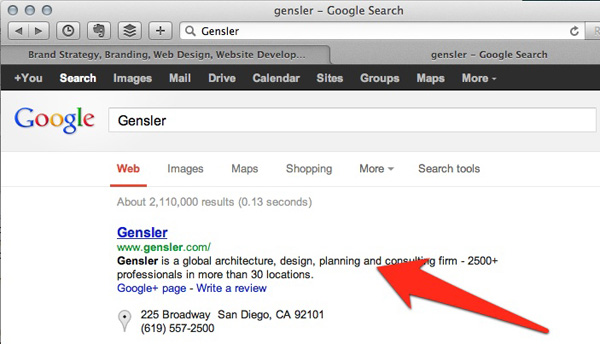
Appears: black text in Google results (see red arrow above)
Length & Format: Up to 155 characters
Concept: Compelling ad copy that inspires user to click
Example: Home: LecoursDesign is a brand strategy firm serving the AEC Industry. We help clients tell their story to win new business.
Best Practices: Accurately summarize page content
Avoid: only keywords, generic descriptions, quotes
4. H1 Tags
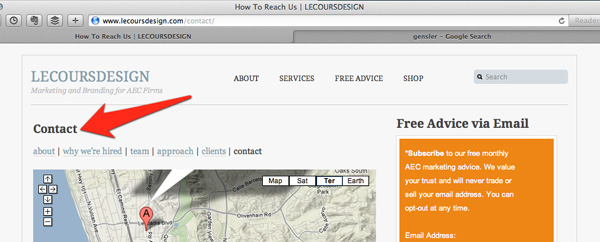
Appears: Headline title on each page (see red arrow above)
Length & Format: No more than 1 line, could be 1 word
Concept: Compelling headline that ideally contains primary keyword for that page
Example: Contact
Best Practices: Every page needs a unique H1 tag
Avoid: making H1 tags exact copies of page titles
5. Keywords
Appears: n/a
Length & Format: 5-6 words or phrases comma separated -or- 1 primary keyword (there are differing beliefs on this)
Concept: primary keyword, secondary keyword, etc. if using multiple keywords
LecoursDesign Example: Brand Strategy, Branding, Logo, Web Design, AEC Marketing
Best Practices: Think like a searcher. What words would they use to find you. Unsure about which words to use? Use http://www.google.com/trends/. For example, I was unsure about which keyword is searched for more frequently: brand or branding. Below are the results:
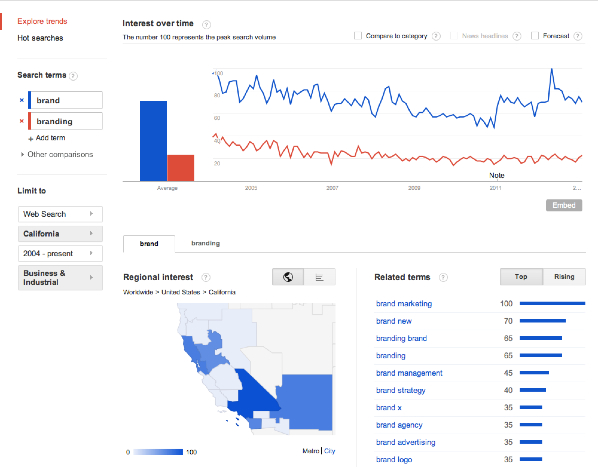
6. Body Copy
Write compelling content that is helpful to your audience. Speak directly to your reader by identifying their pain points and offering solutions. This post is an example. I heard from several clients that they were confused about SEO so I wrote this post to help them. Use keywords in your body copy but only when they make sense. In other words, don’t keyword stuff at the expense of good writing. You want incoming links and nobody will link to your copy if it isn’t readable. In short, if your content isn’t good enough to attract natural links, it doesn’t matter how “optimized” that content is. Finally, make sure content is indexable, not PDFs, movies, image files, etc. A quick way to test is to place your cursor over the text and try to select it. If successful, then it’s indexable.
The Opportunity
The main opportunity with search is attracting potential clients that value your expertise, are unaware of you or your current services, or are considering hiring someone else. It’s unlikely that you’ll convert them on the spot to become a client. But, a relationship with this potential client must start somewhere. Content Marketing + SEO can be the first step in moving this searcher from prospect to client by getting to know you, to like you, to trust you, and eventually hire you.
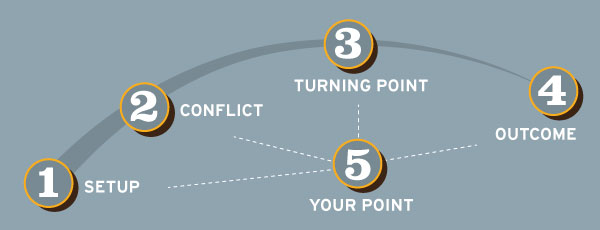
by davidlecours | Nov 13, 2012 | Story

Marketers are buzzing about “story.” Ten years ago, we were frothing about “branding.” Like “branding,” I’m concerned that the term “story” is being applied too liberally, and will lose its credibility. To avoid this, we need to be precise when referring to “story.” Story has a definite structure. By learning this timeless structure, all AEC marketers can better tell stories to win new business.
Robert McKee, a Fulbright Scholar praised in Hollywood for his consulting on narrative structure defines story as “the expression of how and why life changes. A story begins with balance, then something throws life out of balance, then a story goes in to describe how balance is restored.”
In previous posts, I shared why AEC Marketers should use story (the why), and the three stories we must master (the what). Now, I’ll recommend how to craft your stories (the how). Story structure will make your stories, and firm, more memorable. Stories move a prospect along the continuum of getting to know, like, and trust you, and your firm. Well constructed stories filled with emotion and vulnerability build relationships. As you know well, relationships win new business.
Story Structure 101
After reading a gripping novel or seeing a moving film, have you ever wondered if there is a secret formula for story success? There is, and it’s no secret. You may have heard of the famous 3 act play: Introduction, Rising Action, Resolution. I prefer the structure below from What Great Salespeople Do: The Science of Selling Through Emotional Connection and the Power of Story by Mike Bosworth and Ben Zoldan. These 5 stages are the “secret sauce” for all great stories. I’ll use an example of an AEC “Who We’ve Helped Story” to illustrate these 5 stages.
- Setup – This is where you drop your listener into your story. Quickly ntroduce your characters, location, and any relevant background information. To make your protagonists likable, share what makes them human (dreams, fears, desires, etc.). The audience needs to connect with your project team and want them to succeed.
- Conflict – If there is no struggle, there is no plot. It just isn’t interesting. There needs to be something formidable that stands in the way of your project team’s success. In the AEC world, this could be timing, personalities, budget, politics, or physical constraints.
- Turning Point – Stories are explanations of how and why life changes. This is the aha moment that changes your team. This could be some new insight that alters how your team solves problems on the job site, or the reason why you entered a new market. The turning point could even be an epiphany that changed the strategic direction of your firm.
- Outcome – This is an untangling of events in your story. Think of movie credits rolling where we learn what your favorite characters are doing with their lives today. The resolution explains how your story ends and what effect the experience has had on your team.
- Your Point – In this stage, you reinforce your theme or point of your story. This is often a core belief or value that your firm holds. If your firm has a new way of delivering projects, this is where you would share that process. It might sound something like this, “as a result of what we learned by continuously overcoming X, our firm believes that Y not only is the best way to deliver projects, but it also separates us from our competition.
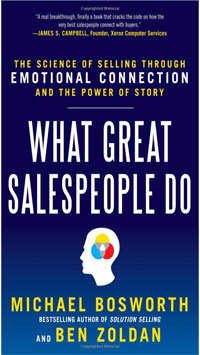
Recommended Story Development Process
The way in which you develop a good marketing story is not the order in which you ultimately write or tell that story. Because clarity and brevity are so important in marketing stories, write or tell the story in chronological order (stages 1 thru 5 above). Develop the story in this order:
- Your Point – Ask yourself, “why am I/we telling this story?” Possible answers may be to share your impressive safety record, demonstrate your creativity, or persuade that your project delivery method saves money. Always start with why.
- Outcome – To make sure your story ends in a way that supports your point.
- Setup
- Conflict
- Turning Point
Now you have the key elements, practice writing or telling the story in chronological order.
Share Emotion
Great story structure without emotion is like a jumpy house before it’s been inflated. Emotion gives it life, makes it interesting, and ultimately memorable. There are 6000 words in English to communicate emotion. Use them to describe how your main characters feel, not just what happened. If you just recount the facts, expect to put your audience to sleep. Consistently ask yourself, how did your protagonist feel at each stage of the story. Feelings are the glue that constructs real and likable characters. Emotional connection is also what makes your story, and your firm memorable.
Reveal Vulnerability
This is the hardest thing to do for AEC firms. Our work is so highly technical, and we are consistently asserting our expertise, that to reveal vulnerability seems weak. But we actually gain power when revealing vulnerability. Try this with a friend. Reveal something you may be struggling with, or a mistake you’ve made and watch what happens. Because of what neuroscientists call mirror neurons, your friend will most likely share something vulnerable in return. In simple terms, this “monkey see, monkey do” behavior is a mutual exchange of emotion. This is the definition of a relationship. By telling your story, your prospect may tell you their story. This is where you learn what your prospect’s pain points are, and what you can do to solve them. It takes courage, but going first in revealing vulnerability, is critical. You establish that it’s safe to be real, that your prospect can trust you with their authentic story. It’s counterintuitive, but vulnerability makes you more likable, not less. Perfection is boring, stiff, and lifeless. It’s our imperfections, that make us likable. Stories about when your firm made a mistake, what you did to correct that error, and what you learned, are incredibly powerful relationship builders.
Nothing is more intimidating to a writer than a blank sheet of paper. My intention is that this post serves as a template for you to jump-start your stories. By utilizing a proven story structure, and integrating emotion and vulnerability, you will create stories that elevate your firm’s proposals, presentation interviews, and websites to win new business.
What Do You Think?
Does having a structure constrain or enhance your creative storytelling?
Any examples of where you’ve revealed vulnerability, and it’s helped or hurt you?
Related Posts
Why AEC Marketers Must Master The Power of Story (The Why)
3 Stories AEC Marketers Must Master (The What)
Recommended Books on The Power of Story To Win New Business
What Great Salespeople Do: The Science of Selling Through Emotional Connection and the Power of Story by Mike Bosworth, Ben Zoldan
The Story Factor by Annette Simmons
Tell to Win: Connect, Persuade, and Triumph w/ Hidden Power of Story by Peter Guber
resonate: Present Visual Stories that Transform Audiences by Nancy Duarte
Made to Stick: Why Some Ideas Survive and Others Die by Dan and Chip Heath
by Dan and Chip Heath
A Whole New Mind: Why Right-Brainers Will Rule the Future by Dan Pink
by Dan Pink

by davidlecours | Aug 14, 2012 | Story

As AEC Marketers, we are in the business of persuasion. Aristotle, the father of persuasion, defined it is a combination of logic (logos), emotion (pathos) and credibility (ethos). Our industry is really good at two out of three of these tactics: logic and credibility. But 67% would earn us a “D” if enrolled in Persuasion class. We must connect emotionally to be fully effective. Story is the perfect vehicle custom-built to deliver emotion.
Is emotional connection too squishy, warm & fuzzy, Kumbaya for the AEC industry? No, we are already using it. Our industry is built on relationships. How are relationships built? By creating positive emotional connections one person at a time.
Stories Help Us Lead
Quick, who are the greatest leaders in American history? I’ll wait for you to list three. Your list might include Kennedy, Lincoln, or Martin Luther King because a common skill among great leaders is the ability to tell stories. This extends beyond politics. When musicians, actors and athletes use story: as defined as authentic expression that moves audiences on an emotional level, they become idols. While our goal may not be hero worship, storytelling helps us lead in business too. Beth Comstock, Chief Marketing Officer of GE says, “you must first tell a story, before you can sell a story.” Leadership and storytelling are inseparable. Plato said, “people that tell stories rule the world.” Which market would you like to rule?
Story Allows Us In
Nobody likes to be sold. We feel manipulated. Our audience keeps their defenses up against our persuasive charm. But story can let you in. When people listen to, or read a story, they become physically more receptive. They relax their shoulders, release their jaw, and even lower their heartbeat. Story also induces mental relaxation. Listeners become less analytical and can reach a trance-like state. This is why parents read stories to their children before bedtime. Story connects to the subconscious and imagination centers of the brain. Story, like a Trojan Horse, gets us inside the gate to then move our audience to act.
Story Moves Our Audience to Buy
Human beings liked to be moved on an emotional level. It makes us feel alive. We seek out emotional experiences on the page, stage, screen and stadium to escape from our overly logical lives. While logic makes people think, emotion makes people act. We purchase using emotion and later justify with fact. Think about the last big purchase you made. Maybe it was a house or a car. Sure, you did logical research. If you are really nerdy, you created a spreadsheet comparing positive and negative attributes among your choices. But, when you had to decide, you probably went with your gut. You walked into your new house and it just felt right. Selection committees don’t choose a firm solely based on lowest fee (a logical decision). Emotional connection, a feeling that the team will be great to work with, influences the final decision.
As Professional Service Marketers, all we sell is a promise to deliver. This promise must be credible (your firm’s reputation) and logical (proven project delivery method). These two attributes will get you on a short list. Harnessing the power of story to connect emotionally can win you the work.
Next Post To Read
How to Craft AEC Stories To Win New Business
The 3 Stories AEC Marketers Must Master
Books That Have Informed My Thinking on Storytelling To Win New Business
What Great Salespeople Do: The Science of Selling Through Emotional Connection and the Power of Story by Mike Bosworth, Ben Zoldan
Winning the Story Wars: Why Those Who Tell the Best Stories Will Rule the Future by Jonah Sachs
The Story Factor by Annette Simmons
Tell to Win: Connect, Persuade, and Triumph with the Hidden Power of Story by Peter Guber
resonate: Present Visual Stories that Transform Audiences by Nancy Duarte
Made to Stick: Why Some Ideas Survive and Others Die by Dan and Chip Heath
by Dan and Chip Heath
A Whole New Mind: Why Right-Brainers Will Rule the Future by Dan Pink
by Dan Pink
Your Thoughts?
Has your firm used story to win new business?
When have you used story? In bios, project sheets, firm overviews, presentation interviews?
Do you find written or oral stories to be more effective?
by davidlecours | Apr 13, 2012 | Presentations

Within a monarchy, it’s essential to know your role. The same is true for great PowerPoint style slide presentations. Your effectiveness as a presenter will increase royally by understanding the purpose and relationship of 3 key roles: Audience, Presenter, and the Presentation.
Your Audience is King
The only reason your presentation exists is to serve the King (your audience). Too many presentations fail because they are all about the presenter. When this happens, the King will demand your head. A great way to keep your head is to check your ratio of I/we to you. Use the word “you” at least three times as much as the words “I” or “we.”
As you develop the content of your presentation, keep asking yourself, “how does this serve my King?” This will be your filter for deciding what gets included in your presentation.
Your audience is a dubious King who wants to know why he should listen to you. To establish credibility, have someone else introduce you prior to going on “stage.” You must also be likable. Showing authenticity and vulnerability through personal story or self-deprecating humor is effective. The dubious King must then be persuaded why he should adopt your point of view. A combination of logical and emotional argument is best. Once the King likes you, decides to adopt your point view, then you must define the next action for the King to take.
The Presenter is the Star
As the presenter, you are the Star hired to entertain, inform, or persuade the King. The King has come to see you, not your slides. Presenters often make the mistake of thinking their slides are the star. Don’t hide behind your slides believing they will perform for you. If, in your presentation, you simply read your slides, then do everyone a favor by canceling the presentation and send them a PDF. Think of your slides as scenery that supports your performance.
The Star deserves a spotlight. Presenters often make the mistake of turning off the lights to make their slides look better. Remember, you are the Star, not your slides, so make sure you are well lit. This will keep the audience awake and allow them to connect with you. Today’s projectors are powerful enough to project your slides, even in a well lit room.
You need to put on a show. All business is show business. You can still be authentic, but think of your delivery as a heightened version of you. Ramping up your enthusiasm, vocal variety, storytelling, dramatic effect is expected of you. This takes practice and knowledge. If you need help in this area (I certainly did), then I recommend joining a Toastmasters Club. It’s a fun, safe and engaging way to elevate your charisma in front of an audience.
Your Presentation is a Present
As the Star, you are giving a present-ation to the King. The King doesn’t like to be confused. So it must be incredibly clear why you are giving this present, what this present is, how it will benefit Your Majesty, and what the King is supposed to do next with your present.
First, decide what the purpose of your presentation is. As Simon Sinek suggests in his famous TED Talk, start with why. Why are you giving this presentation? Is it to inform, entertain, or persuade? What is your topic? Then develop your unique point of view on that topic, a thesis that will run throughout your presentation.
Stephen Covey’s “Begin With The End in Mind” is a great way to develop presentation content. Consider at least 3 benefits the audience will receive if they adopt your thesis. Once they’ve adopted your thesis, decide what you want your audience to do next. A call to action is a powerful way to end a presentation.
Conclusion
A Star Performer brings a present to the King. This sounds like an intro to a joke. But, if you’ve been there, standing in front of your audience about to begin, you want to be taken seriously. To help you succeed, remember the roles. You are the Star, gifting your presentation (a present), to the King (your audience). Do this, and the crown will become yours.
Similar Posts
by davidlecours | Dec 9, 2011 | Presentations
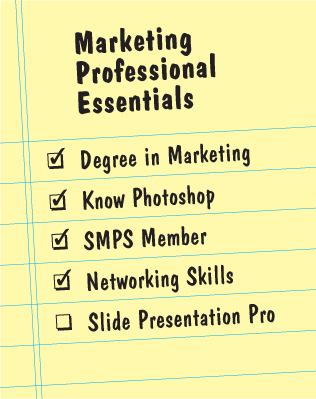
As marketers, we are required to be persuasive. Externally, our primary job is to persuade prospective clients to hire our firm. Internally, we have to persuade our Principals, or CFO, to endorse and fund our marketing plans. Presenting with slides, using PowerPoint or Keynote, can be an incredibly powerful way to make an emotional connection with your audience. Therefore, this is a skill that all marketing professionals should possess. But very few of us have received any training in how to develop, design and deliver a persuasive slide presentation. For the next several blog posts, I will share my expertise as a professional speaker and graphic designer to provide you with simple, timeless tips to help you deliver slide presentations like a pro.
Why Should You Develop this Skill?
To be perceived as a leader in your firm, you must be able to present your ideas clearly and persuasively. There is a direct link between leadership and presentation skills. In fact, Toastmasters International, the worldwide organization previously known for developing public speaking skills, has just rebranded with the tagline “Where Leaders Are Made.” Having the ability to present well will not only gain you the respect of your firm’s Principals, but will also serve you well in persuading your entire firm to embrace your marketing plan. Outside your firm, this skill will enable you to present at industry conferences and raise your value to firms looking to recruit you.
The Problem
Most PowerPoint presentations are dreadful. You’ve probably heard the term “Death by PowerPoint” or perhaps you’ve read “Really Bad PowerPoint” by Seth Godin. Powerpoint is almost universally hated because most presenters develop, design and deliver slides that do not engage their audience. I’m sure you’ve suffered through a presenter turning his back on the audience to read 15 bullet points. Don’t blame the presenter, blame his education. With plenty of classes in Literature, English, and Writing, you were well educated in verbal communication. Unless you attended art or design school, you didn’t receive an education in visual communication. Yet PowerPoint forces people communicate visually. So, what do presenters do? They revert to what they know (verbal communication) by placing a bunch of bullet points on a slide. This is the quickest way to lose the attention of your audience.
A Great Presentation is a 3 Legged Stool
The 3 legs to your presentation are Development, Design and Delivery. Remove one of these legs and your presentation will end up on its rear! You’ll want to begin with the development of your content. Consider why you are making this presentation, who is the audience, and what do you want them to do. Start to outline your main points and gather evidence, stories and imagery to support those points. Next, you’ll want to design simple, clear slides that support you and your message. I recommend including 1 message per slide. Finally, you’ll need to practice your delivery so that you are confident in front of your audience. Remember that you are the star, not the slides. If the slides can live on their own, then cancel the presentation and send the audience a PDF.
Read Next
Slide Presentations Like a Pro: Roles
What Do You Think?
Do you have a favorite TED Talk that effectively uses slides?
Do you have a PowerPoint horror story?
What tips can you share for creating slide presentations?
If you want to see the principles mentioned in this post in action, purchase a DVD or Online Download of Change the World Slide by Slide: How To Design & Deliver Professional Slide Presentations.
Similar Posts
How to Give The King’s Speech: Lessons Learned From the Oscar Winning Film
Using Public Speaking To Attract Clients











